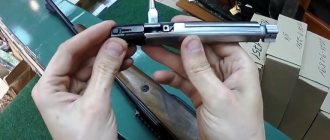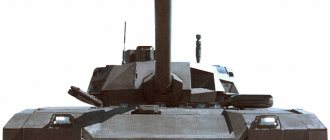Tukhachevsky and easy prey for the Basmachi
Tukhachevism (after the name of the notorious marshal) is the injection of crazy money into outwardly spectacular, but completely useless weapons systems.
Moreover, the country does not have the truly necessary samples during a real war. Remember how all these radio-controlled boats and tanks, universal guns and anti-tank torpedoes became completely stillborn? While the USSR, until the end of the war, did not have its own aircraft - fire spotters, like the German “frame” FV-189, or armored personnel carriers? Recently, my attention was drawn to the garishly tabloid headline “Russian deadly “Marker” will be prepared in a year.”
“The project of the Russian deadly robot “Marker”, first presented in October 2022, will be completed in 2021. This was reported to RIA Novosti by the head of the scientific and technical council, deputy general director of the Foundation for Advanced Research, Vitaly Davydov.
According to him, the car will become completely autonomous. “The operator will only issue target designation, and the robot will decide how to move towards the target, taking into account the type of terrain, overcome obstacles encountered along the way, and select and use the optimal type of weapon on the spot,” the specialist said.
“We need to end this kind of propaganda frenzy. To audit what is being done in the military-technical sphere, mercilessly discarding Tukhachevism and outright milking of the budget on military-patriotic hype.”
Davydov noted that by now the Marker can work with small arms and destroy ground and air targets, and in the near future the vehicle will be tested with a grenade launcher. In the future, according to the general director, the device will be able to be equipped with drones.”
Before us is the reincarnation of wedges from the twenties and early thirties. A technique that suffered a crushing fiasco and turned out to be a dead-end branch of development. Only here is an unmanned option. Imagine these robots on the battlefield. They are too small to overcome large obstacles and are extremely vulnerable.
Let’s open the article by Igor Shmelev “At-Arms of the 20th Century” (“Technology for Youth”, No. 7, 1979). During the First World War, “Colonel J. Etienne and English Major J. Martel dreamed of “swarms of armored skirmishers” back in 1915. This idea was revived after the war by the famous military theorist J. Fuller. He believed that it was necessary to have a lot of light and cheap to produce armored vehicles, designed for one or two people.”
The USSR did not escape this fashion either. And there they began to construct cheap wedges using components of ordinary cars and engines of 18–40 horsepower. How good! Motorized knights of the industrial era are replacing the infantry with machine guns!
However, real combat operations have shown that wedges cannot overcome large ditches and holes due to their miniature size. In addition, they are destroyed not by cannon fire, but even by machine guns and rifles: their armor is too thin. Unlike an infantryman, a tankette cannot hide in a trench or crater from a shell. When the Red Army tried to use T-23 wedges during the war with the Koltoman Basmachi in Turkmenistan in 1932–1933, it was faced with huge losses. The Basmachi shot them with machine guns, caught them in “wolf pits” and then doused them with gasoline and threw torches. Saudi Arabian troops acquired the same sad experience in the same years when faced with Yemeni troops. Bolivia tried to use small tanks in the war with Paraguay in 1932–1935. And the Italians’ attempts to use them to support infantry attacks in the Spanish War of 1936–1939 finally put an end to wedges. The concept of mechanized “infantry armor” in this form turned out to be a failure. The surviving wedges were used for reconnaissance and combat protection.
"Marker". Photo: fpi.gov.ru
And now they offer us a robot wedge. It is easy to imagine what a desirable prey they would be for machine gunners, for snipers with large-caliber rifles, and even for ordinary infantry. As well as for small attack drones. Throw such vehicles into a city battle, and the skeletons of damaged robots will clog the streets. Arrows from houses and ruins snap them like seeds. So why do we need such “deadly robots”? To use public money and show a beautiful picture for an enthusiastic electorate? Discussions about introducing a fourth “robot platoon” into motorized rifle companies are fairy tales, a repetition of the tankette utopias of the 1920s.
Of course, one can assume that solutions for a large robot tank are being worked out at Marker, but here I am tormented by great doubts. In urban environments (and for fighting terrorists), walking and climbing robots are more suitable than crawler robots. And the future of tank forces is combat swarms of specialized vehicles working in conjunction with attack drones and attack helicopters.
In a word, before us is more likely a new Tukhachevism than a truly promising weapon. Money down the drain for the sake of external propaganda effect. For in real, not fictitious, wars, such a technique will not be useful, just as many of the projects of the marshal-projector once turned out to be unnecessary. Wars, meanwhile, are more likely to be partisan and irregular. And ground robots are needed primarily for such conflicts.
There is a lot to learn from the “stupid Pindos,” by the way. There’s nothing wrong with that – we learned a lot from the Germans in our time.
Wedge heel
Wedge heel
(English wedge - wedge) - women's shoes in which a thick sole in the heel area tapers to a thin one in the toe area. Similar design of shoe soles could be seen at different times in different civilizations - see the article - Platform shoes.
The term “wedge” came to the shoe industry from the military department, where it meant a lightweight, high-speed machine. Women's wedges and wedge sandals
got their name because of the external resemblance to the tracked vehicle of the same name, which can be seen if you look at the shoes from the side.
In the history of fashion, the Italian shoemaker Salvatore Ferragamo is considered the inventor of the wedge heel.
Due to economic sanctions imposed on Italy following its 1935 invasion of Ethiopia, the country began to run out of materials that were traditional for shoe production. Salvatore Ferragamo decided to try new methods, remembering forgotten materials, and began making cork soles, which were common in Italy in the 15th century, during the fashion for chopines. Ferragamo came up with the idea of filling the space between the toe and heel of the shoes with balsa wood from Sardinia. This material was distinguished by strength, lightness and durability. For the first time, a full-fledged model of wedge shoes
the designer introduced in 1935. Comfortable and practical, it came in handy. The wedge heel gained popularity and began to be copied by other masters.
Wedge shoes
, just like platform shoes were fashionable in the 1940s. In the 1950s, many women wore comfortable wedges, but they were not considered fashionable.
The triumphant return of platforms and wedges occurred in the 1970s.
Since then, the wedge heel has firmly held its position and periodically enters the fashionable shoe top.
In the 21st century, sports shoes with wedges
–
wedge sneakers
,
wedge sneakers
,
wedge sneakers
, wedge tennis shoes, etc.
In 2011, French designer Isabel Marant began producing high-top wedge sneakers.
, which in Russia are often called sneakers or
wedge sneakers
(from the English sneakers, which actually means sneakers).
Wedge-heeled sneakers
very quickly gained popularity among Western stars; the trend of wearing sneakers in this style began to gain momentum and became an integral part of modern fashion.
Category: ABC of fashion
Tags: Wedge | wedge shoes | wedge sandals | wedge sneakers | Wedge Sneakers
The Mule and the Squire
The Yankees decided to equip their special forces and light infantry with the ultra-passable six-wheeled robot SMSS. It can carry 300 kilograms of cargo, following a unit or one of its fighters, and independently. It is also controlled using a remote control. There is also the option of moving from one geographical point to another using satellite navigation.
Wedge heel Carden-Loyd 1928. Drawing by Mikhail Petrovsky
Unlike “Marker”, before us is an analogue of a hardy mule and a squire. His task is not to go into battle (he will be quickly destroyed), but to carry equipment and ammunition behind the fighters. And if necessary, the SMSS will carry the wounded. But the “Marker” is useless here. The Americans very correctly realized that a modern soldier is forced to carry essentially the armor of a Roman legionnaire or a medieval bollard, the same quarter quintal. Helmet, body armor, weapons with ammunition, communication equipment, first aid kit, water and rations. And our warrior with the “Warrior” kit is heavily loaded. That's why you need to have your own robot mule. So as not to turn sour during the transition.
The Americans chose a very successful chassis. Before us is nothing more than a six-wheeled youth all-terrain vehicle of the “Jiger” type, popular in the 1960–1970s. In the West, several of their models were produced, calling them something between a tractor and a car (light “jigers” were controlled by levers, not by a steering wheel). With engines ranging from eight to 55 horsepower, they could walk on virgin soil and take inclines of up to 45 degrees. At the same time, being able to turn around and swim. I think that such vehicles, and not only in robotic form, are needed for special forces or irregular militant groups no less than the famous buggies. Which are now increasingly used by the troops.
Now you can see for yourself what is more useful for the real wars of today and tomorrow: the reincarnation of the Marker wedge or this robot jiger. And who has a more rational approach to new military equipment?
Characteristics[edit]
Wedges were produced in both double and triple versions. Some of them were so low that the passenger had to lie prone. [3] Some models were not equipped with turrets (and together with tracked mobility, this is often seen as defining the concept) or just a very simple turret that could be moved by hand or foot. They were significantly smaller than light tanks and did not have a tank gun; instead, their primary weapons tended to be one or two machine guns or, less commonly, a 20 mm autocannon or grenade launcher.
Examples[edit]
German Wiesel, a related modern concept seen here in the anti-aircraft version of Ozelot
.
- United Kingdom Carden Loyd
- Morris-Martel
- L3/33
- Type 92 Ju-Sokosha
- TKS / TK-3
- AH-IV
- T-17
- Renault UE Chenillette
- Panzer I - Although classified as a light tank, most variants fit the wedge designation.
- Marmon-Herrington CTLS - wedges not officially designated











